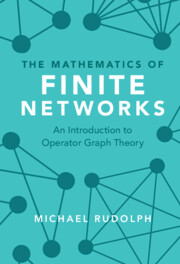Book contents
- Frontmatter
- Dedication
- Contents
- Preface
- 1 Introduction
- Part I Operator Graph Theory
- 2 Classical Graph Theory: The Mathematical Description of Networks
- 3 Operator Calculus: The Mapping between Vector Spaces
- 4 Operator Graph Theory: The Mathematics of Finite Networks
- Part II Applications
- Afterthought
- Bibliography
- Index of Notations
- Subject Index
2 - Classical Graph Theory: The Mathematical Description of Networks
from Part I - Operator Graph Theory
Published online by Cambridge University Press: 30 April 2022
- Frontmatter
- Dedication
- Contents
- Preface
- 1 Introduction
- Part I Operator Graph Theory
- 2 Classical Graph Theory: The Mathematical Description of Networks
- 3 Operator Calculus: The Mapping between Vector Spaces
- 4 Operator Graph Theory: The Mathematics of Finite Networks
- Part II Applications
- Afterthought
- Bibliography
- Index of Notations
- Subject Index
Summary
What do the bridges of Königsberg, synaptically connected neurons in our brains and the galaxies illuminating the dark voids of our universe have in common? All of these real-world phenomena can be described as collections of discrete discernible objects which are interlinked to form weblike structures called networks. This chapter will introduce the mathematical representation of such networks, and familiarise us with the basic concepts, ideas and terminology of a vast and ever-growing research field whose roots date back to the work of Leonard Euler. By taking a closer look at a number of concrete network models - specifically the random graph models which prominently feature as descriptive vessels for many natural phenomena - and briefly exploring some deep-rooted conceptual limitations of these models, we hope not only to motivate the need for a rigorous mathematical framework for the study of networks at finite scales, but also to accentuate the potential advantages of a more dynamical vantage point from which to view networks and their defining characteristics in later chapters of this book.
- Type
- Chapter
- Information
- The Mathematics of Finite NetworksAn Introduction to Operator Graph Theory, pp. 13 - 87Publisher: Cambridge University PressPrint publication year: 2022



